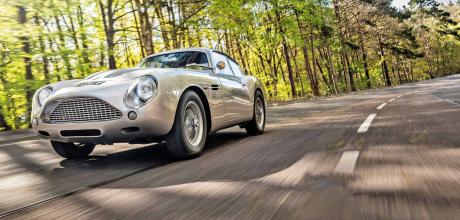1961 Aston Martin DB4GT/Zagato modified
Rebodied by Zagato, this original Aston Martin DB4GT is elevated above the many GTZ replicas as a test drive reveals. Words Ivan Ostroff. Photography Neil Fra.
Reborn 2 Be Wild Testing a genuine Aston DB4GT clothed later in life by Zagato
A rare drive in an Aston Martin DB4GT rebodied by Zagato in the 2000s
Rare Aston DB4GT driven
Ever since the Aston Martin DB4GT Zagato was introduced at the London Motor Show of 1960, it has been generally acknowledged as one of the most attractive and elegantly styled motor cars in history. The silhouette of this quintessentially British Aston Martin, combined with the Italian design flair of Zagato, described one of the most charismatic automobile designs ever conceived. Those curvaceous flanks, the ‘Z’ logo of Zagato Milano below the vents on both front wings, double power bulges running the length of the front-hinged bonnet, Frenched rear lights, twin leather straps securing the bootlid, and twin exhaust pipes exiting on the near side – this Italian-suited British bulldog has always been one of my favourite motor cars. This one, based on a genuine DB4GT chassis (unlike Sanction II/III Zagatos, which were based on standard DB4s) was rebodied by Zagato itself in the early 2000s as part of a comprehensive rebuild. Currently set up for road use, it’s capable of accelerating to 60mph in less than six seconds, and can reach over 150mph at 6000rpm in top gear. Even by today’s standards, this is an extraordinarily fast car, and its especially interesting history makes it just as intriguing as any of the 19 original DB4GT Zagatos made in the Sixties.
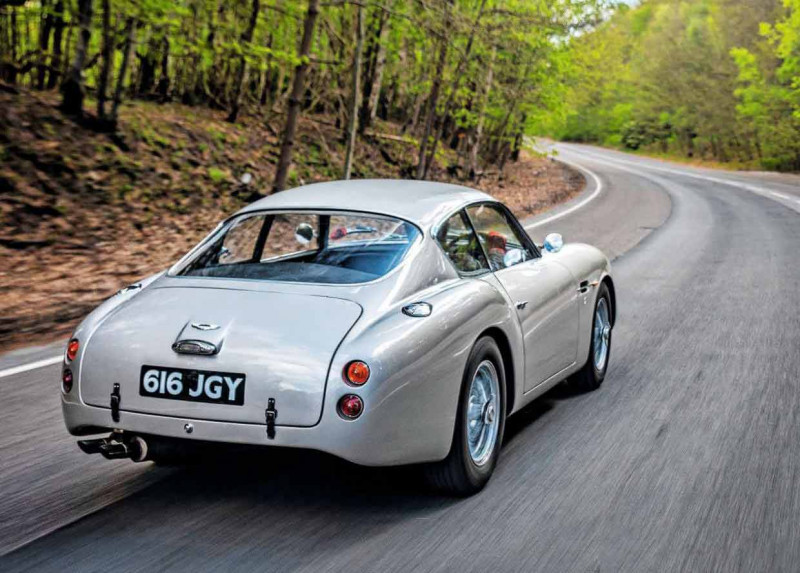
The interior is complemented by a plush rear compartment upholstered in black quilted hide with securing straps for luggage while on a grand tour. A thoroughly business-like fire extinguisher sits on the floor behind the passenger seat but because this car is no longer used on the track, there is no rollcage to negotiate. I lower my backside onto the driver’s seat; the rather flat looking cushions belie the level of comfort they provide. The wood rim ‘ban-the-bomb’ three-spoked steering wheel allows a naturally straight-arm driving position, my feet fall perfectly on the pedals and I have a clear vision of all the instruments set within the standard traditional Aston Martin display. The 7000rpm tachometer has a redline marked at 6000 and the speedometer reads to 160mph; the binnacle also contains fuel/water temp gauges, an ammeter and oil temp/pressure dials. Set into the centre of the dash is a Smiths clock. Being a road car it has a radio fitted and the usual heater controls quadrant.
‘Accelerating away hard in first, the tachometer spools gleefully and two thick black lines are laid on the road with little effort’
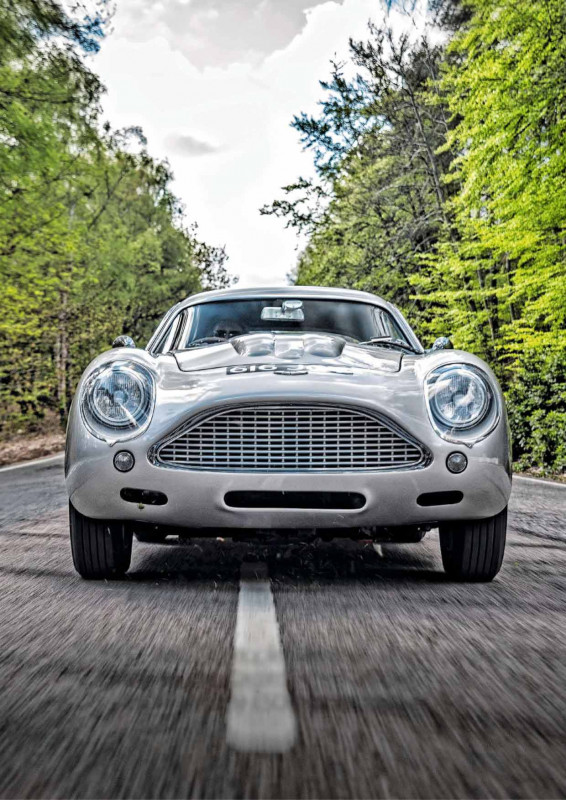
I turn the key and the starter spins with a high-pitched whirr. The engine fires and I smile involuntarily as I listen to the three big Weber 45DCOE carburettors inhaling great volumes of air, while the distinctively Aston exhaust booms out of the twin pipes at the rear. Meanwhile up front, belts spin and camshafts whirr while the mechanicals warm through. Eventually, it’s up to temperature, so I drop the handbrake and move the skinny gear lever forward into first. The clutch is a little on the heavy side and I have to make sure that it’s fully depressed to engage gears smoothly. The gearchange is light and positive, although the gear lever is almost a foot tall so somewhat spindly to use. I can sense the take-up of power through the rear axle and the slight movement of the Watt linkage under duress from all 345 horses. Traction is exceptionally good, and there is clearly rather more poke than in a standard DB4GT, the result of some postrebuild tuning in its racing years. Accelerating away hard in first, the tachometer spools gleefully and two thick black lines are laid on the road with little effort. The straight-six remains tractable throughout the rev range. There’s no feeling that unless I keep the engine up on the cam it won’t pull smoothly, so the car feels very easy and most pleasant to drive. With its standard David Brown gearbox, you cannot smash through the gears – you need to be slow and sympathetic; it is, however, precise in movement.
There are 2.8 turns of the wheel from lock-to-lock and rack-and-pinion steering is weighty at slow speeds, but it’s precise with loads of feel through the wheel, so that I know all the time what the front wheels are doing and how well they are maintaining their grip. This is a quick car; thankfully the roadholding is excellent. Today, these cars tend to wear slightly wider rubber than they would have in the Sixties, and with a vastly improved compound. The Michelin 600 x 16 tyres back and front stick tenaciously so active provocation is required before the back end begins to slide. Once you do get it moving around though, everything comes together and the car exhibits a beautiful balance.
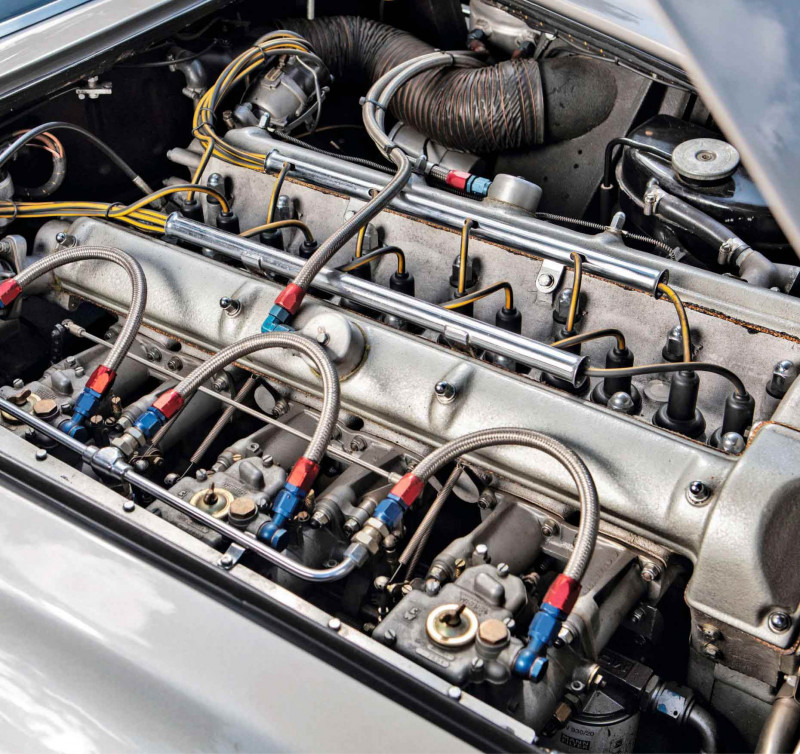
Moving from one gear to the next, the car pulls strongly and smoothly throughout its rev range. I floor it at 3000rpm in third; it’s pushing me back into the seat. Climbing through 4000, I keep the throttle pinned to revel in that deep bellowing exhaust growl as it accelerates away. At 5000rpm I slip it back into top and prepare for the long left-hander approaching. I’m getting a bit over-confident, a smidgen too fast, so I press down on the brake and feel the pads bite reassuringly on the Girling discs as they haul off speed. There’s no servo assistance but the brakes are very effective with excellent feel. As the steering weights up going into the corner, I can sense the weight at the front combined with the limited-slip differential effect trying to push the Aston straight on. As I approach the next corner, I know what to expect, compensating by braking earlier, screwing on more lock than usual and prodding the accelerator. The tail twitches slightly then starts to slide; a tad of correction on the wheel and we’re pointing in the right direction. Accelerating away in third gear, the standard-equipment Powr-Lok differential does its job perfectly. There is no lack of traction as 345bhp and 325lb ft pegs my shoulder into the seat and the Zagato’s rev counter spools.
‘For longevity, more modern materials were to be used within the dampers, clutch and gearbox internals’
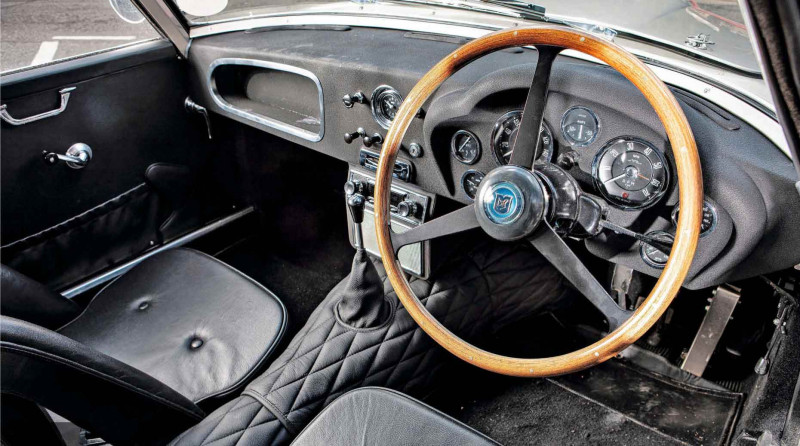
This suspension is well sorted, the car has little roll and doesn’t lean in the corners as long as I keep the throttle planted and the weight transfer maintained towards the rear. Going through a slow corner, I find myself winding on a little extra lock as the suspension and the steering weights up. The GT is a most pleasant car to drive – well balanced, manageable and a delight to control on the throttle without becoming intimidating. It has a natural bent towards safe understeer; oversteer needs to be intentionally induced, but also meted out sensibly to not slow the car too much. Find a harmonious balance and the Aston rewards.
Of course, the DB4GT and its Zagato-bodied offshoots were developed with racing success prioritised and road manners deemed a mere bonus, so it’s no surprise that the suspension is on the firm side. Nevertheless, taking this car cross-country would be no great hardship. Granted, the original DB4GT body by Touring of Milan was good looking and well balanced but to my mind Zagato made it into one of the best-looking GTs ever drawn, and the more you drive it the better it gets.
‘The cost of transforming it into the DB GT Special amounted to £5000 – more than a new DB6’
Yet in 1960, only 19 people saw the value in paying £5470 for the Zagato variant when a DB4GT cost £4500, already £500 more than a standard DB4. The GT’s 5in-shorter chassis were shipped out to Italy, where their more curvaceous bodies were beaten out by hand rather than wheeled as we do here in England. The Milanese bodies were 45kg lighter which, combined with higher compression and mildly re-tuned engines, resulted in cars that were quicker by a modest margin – but one that might prove vital in the heat of an on-track battle.
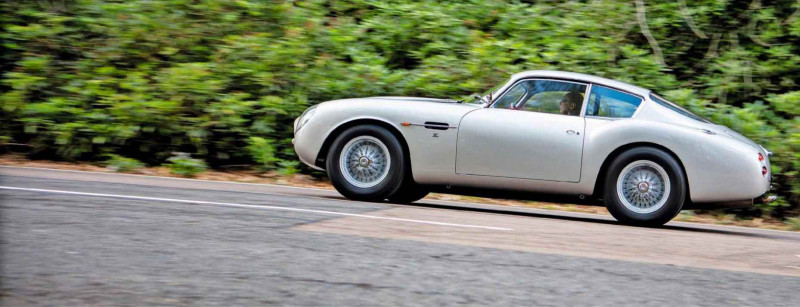
In 1987, Aston Martin sanctioned the construction of four more DB4GT Zagatos with chassis numbers that had not been used on the original run of cars in the Sixties. These are known as ‘Sanction II’ Zagatos. Following completion of these chassis, the vehicles were dispatched to Italy where their Zagato bodywork was mounted. However the coachbuilder was unable to carry out the work in house, so it was contracted out to the workshop of Mario Galbiati, an ex-Zagato employee. The four cars were finally unveiled in July 1991 at the Surrey premises of Aston Martin specialist RS Williams Ltd, whose proprietor led the project, and used his own GT Zagato as the blueprint.
While the bodes of these were faithful to the period cars in every way, suspension was upgraded, modern 15in tyres were fitted instead of the 16in originals, and engines were RSW-fettled 4212cc units with larger Weber 50DCO1/SP carburettors, rather than the original 3.7 litres fed by Weber 45DCOEs.
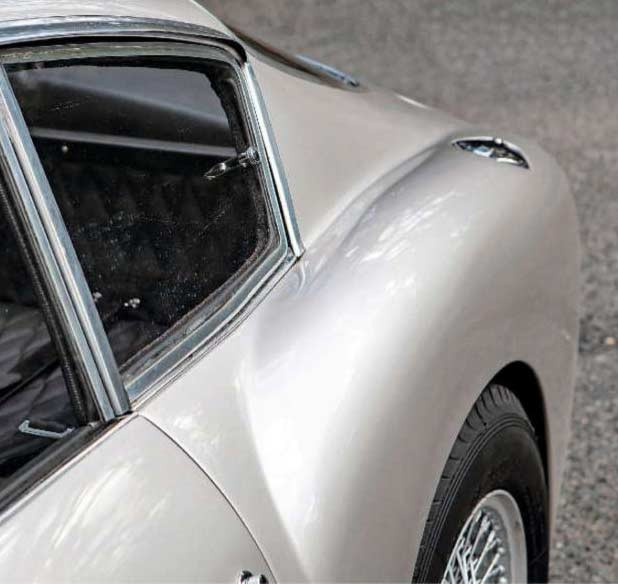
In 1992 AML gave approval for RS Williams to create two more cars from some rough DB4s combined with spare components left over from the Sanction II project. These were finished in 2000 and subsequently referred to as Sanction III cars. Zagato announced that it would not approve any more. Aston chairman Victor Gauntlett referred to them as ‘works-approved replicas’.
In 2019 Aston Martin delivered the first of 19 DB4GT Zagato continuation cars as part of its centenary celebrations. These newly-built factory production vehicles were for race track driving only and were unable to be registered for road use. All were sold with a matching Zagato-designed variant of the DBS Superleggera, each pairing costing £6m plus local taxes.
In 1961, DB4GT chassis 0148/R was first bought by Battle of Britain hero and later chairman of Beaverbrook Newspapers, Sir Max Aitkin. After six years of ownership, it was sold to Robert Buchanan-Michaelson who then sent the car back to Newport Pagnell, requesting that it be rebuilt to his own unique specification, regardless of expense.
Aston Martin removed the bodywork and fitted a DB6 rear end, a Webasto sunroof and a DB5-style front with a custom grille incorporating flush-mounted foglamps and spotlamps. It replaced the tyres with wider 205 x 15 Pirelli Cinturatos and flared the wheelarches to accommodate them. The original 3.7 litre engine gave way to a 4.2 litre unit mated to a five-speed ZF gearbox driving through a DB6 clutch assembly. Armstrong Selectaride dampers were fitted with the usual dashboard-mounted adjustment knob.
The car also gained a steering lock and a smaller steering wheel, a brake servo and DS11 brake pads. Finally it was painted in Garnet red and black with a gold coachline. The car, which resembled a shortened DB6, was referred to by the factory as a ‘DB GT Special’ which was duly inscribed on the door sill kickplates. The cost of these modifications amounted to £5000 – more than a new DB6.
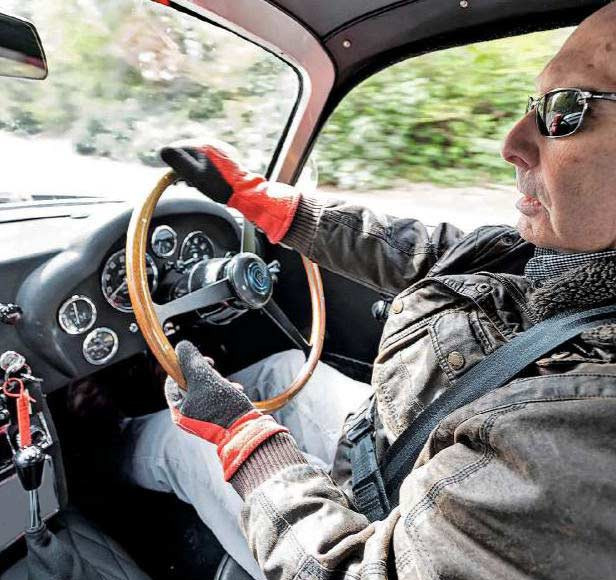
While the somewhat extravagant and possibly incongruous result was frowned on at the time, when Innes Ireland tested the car for The Autocar in July 1969, he commented, ‘Bobby Buchanan-Michaelson wanted to build his ideal motorcar, being a man of fairly extravagant tastes his individualism shows in a strong light. Not everyone will agree with his ideas but then not everyone is in a position to judge.’ Tony Dron also tested the car much later and commented that it was heavier, underpowered and that Aston had made ‘a silk purse into a sows ear’.
In 1976, the car was bought by former AML chairman Victor Gauntlett. It passed through several further owners until early this millennium when its then-owner, a judge, identified the unique opportunity to take this original DB4GT to Zagato specification. He sent it to RS Williams with a brief to rebuild it from scratch and enlist Zagato to clothe it; 0148/R would be indistinguishable from an original GTZ. For longevity, more modern and durable materials were to be used where possible within the dampers, clutch and gearbox internals, such as the synchromesh cones. The original engine was then refitted to the car, albeit enlarged from 3.7 to 4.2 litres.
When it emerged in 2003 as a rebuilt 1961 classic, it was as-new and perfect in every detail. Following the rebuild, the straight-six made 325bhp. Subsequently this was improved to a claimed 345bhp, the work likely having been carried out between 2006 and 2012, when the car was being raced while in the ownership of Chris Scragg. In 2016 current owner Richard Meins took 0148 to Goodwood and raced it in the first Kinrara Trophy, finishing fifth.
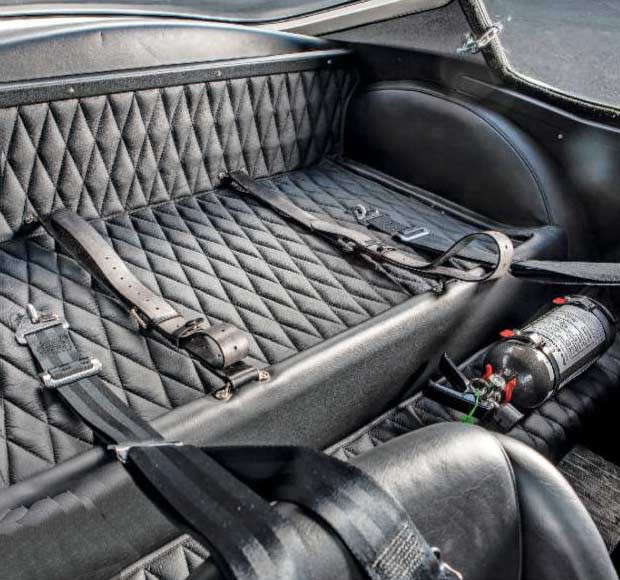
Now, having retired the car from competition, Richard reveals, ‘I’ve kept the suspension as it was when the car was raced, so it is a little stiffer than standard. But I like the feeling that you get behind the wheel, you know exactly what the car is going to do. Frankly, on the road it’s impossible to explore the car’s limits, but when I raced it the handling was fantastic. Considering that the car is rather undeveloped and not an out-and-out historic racer, the Goodwood result was somewhat gratifying. After the meeting, I then drove the car home, just like they used to do in the Fifties and Sixties.’
So is it a genuine DB4GT Zagato? I say that it is. In earlier times, it was quite normal to buy a car and subsequently have a different body fitted. You’d buy a rolling chassis and send it to your coachbuilder of choice for it to mount your chosen body. That body could of course be altered or changed at a later date, and often was. As in this case, the identity of the car remained the same, just upgraded accordingly. This DB4GT gained its Zagato body in the same spirit.
Thanks to: Desmond Smail (djsmail. co.uk); Neil Thomson at RS Williams Ltd (rswilliams.co.uk)
1961 Aston Martin DB4GT/Zagato modified
- Engine 4212cc inline-six, dohc, three Weber 45DCOE carburettors
- Max Power 345bhp @ 6000rpm
- Max Torque 325lb ft @ 4500rpm
- Transmission Four-speed manual, rear-wheel drive, limited-slip differential
- Steering Rack and pinion
- Suspension Front: wishbones, coil springs, Armstrong telescopic dampers, anti-roll bar. / Rear: live axle, parallel trailing arms, Watt Linkage, coil springs, Armstrong lever-arm dampers Brakes Girling discs all round
- Weight 1250kg
- Performance 0-60mph: 5.5sec.
- Top speed: 160mph
- Cost new £5470 in 1960 (factory DB4GT Zagato)
- Current value Approx £3.5m
DB4GT/0148/R’s new body was crafted in Milan under the supervision of Mario Galbiati, Zagato’s restoration manager. GT and GT Zagato engines had twin spark plugs per cylinder for 302bhp and 314bhp
Thanks to covert applications of modern tech, the car is sharper than originals ever were DB4GTs did without the rear bench seat that DB4s came with Every last swoop of the voluptuous body is faithful to the 1961 originals. Now retired from racing, the GT has a creature comforts including a period radio. The Zagato’s celebrated lines were penned by Ercole Spada when he was just 23 years old.
OWNING AN ASTON MARTIN DB4GT/ZAGATO
The owner of DB4GT/0148/R, Richard Meins, says, ‘I bought the car around nine years ago. The DB4GT Zagato really made a lasting impression on me. It was an Aston Martin, it was British and it was mind blowing. I have a preference for British cars and that beautiful designed body by Zagato was for me the perfect combination of Italian style and British motor car. ‘I always wanted a Zagato, and when this car became available I went to have a look. I drove it and thought wow! This is amazing. The engine was built by Richard Williams. It was in full FIA race spec with a cage and fire extinguisher system etc. For the time being I don’t intend racing it again. I don’t want to have to develop it and lose its originality in the process.
‘To convert from a race car to a road car, Desmond Smail removed the rollcage and made a new correct aluminium dashboard to replace the GRP one fitted by Richard Williams. He also removed the fire extinguisher system and fitted a decent radio. He also replaced the brakes and the Watt linkage because there was some wear in the bushes. He then fitted the correct limited-slip differential in place of the race unit it had at the time. ‘As a result, I am now able to use it on the road at will and I do so regularly, as and when I choose. I can even go shopping it!’


